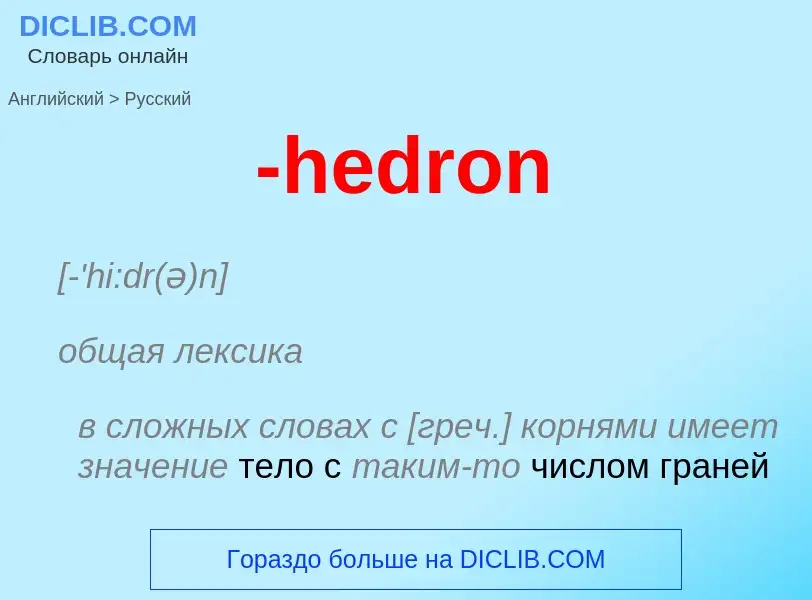Übersetzung und Analyse von Wörtern durch künstliche Intelligenz ChatGPT
Auf dieser Seite erhalten Sie eine detaillierte Analyse eines Wortes oder einer Phrase mithilfe der besten heute verfügbaren Technologie der künstlichen Intelligenz:
- wie das Wort verwendet wird
- Häufigkeit der Nutzung
- es wird häufiger in mündlicher oder schriftlicher Rede verwendet
- Wortübersetzungsoptionen
- Anwendungsbeispiele (mehrere Phrasen mit Übersetzung)
- Etymologie
-hedron - Übersetzung nach russisch
[-'hi:dr(ə)n]
общая лексика
в сложных словах с [греч.] корнями имеет значение тело с таким-то числом граней
общая лексика
энэдр
[aikəsə'hi:drəl]
общая лексика
двадцатигранный
икосаэдральный
икосаэдрический
прилагательное
математика
двадцатигранный
Definition
Wikipedia
In geometry, the rhombic triacontahedron, sometimes simply called the triacontahedron as it is the most common thirty-faced polyhedron, is a convex polyhedron with 30 rhombic faces. It has 60 edges and 32 vertices of two types. It is a Catalan solid, and the dual polyhedron of the icosidodecahedron. It is a zonohedron.
The ratio of the long diagonal to the short diagonal of each face is exactly equal to the golden ratio, φ, so that the acute angles on each face measure 2 tan−1(1/φ) = tan−1(2), or approximately 63.43°. A rhombus so obtained is called a golden rhombus.
Being the dual of an Archimedean solid, the rhombic triacontahedron is face-transitive, meaning the symmetry group of the solid acts transitively on the set of faces. This means that for any two faces, A and B, there is a rotation or reflection of the solid that leaves it occupying the same region of space while moving face A to face B.
The rhombic triacontahedron is somewhat special in being one of the nine edge-transitive convex polyhedra, the others being the five Platonic solids, the cuboctahedron, the icosidodecahedron, and the rhombic dodecahedron.
The rhombic triacontahedron is also interesting in that its vertices include the arrangement of four Platonic solids. It contains ten tetrahedra, five cubes, an icosahedron and a dodecahedron. The centers of the faces contain five octahedra.
It can be made from a truncated octahedron by dividing the hexagonal faces into 3 rhombi:




![This animation shows a transformation from a [[cube]] to a rhombic triacontahedron by dividing the square faces into 4 squares and splitting middle edges into new rhombic faces. This animation shows a transformation from a [[cube]] to a rhombic triacontahedron by dividing the square faces into 4 squares and splitting middle edges into new rhombic faces.](https://commons.wikimedia.org/wiki/Special:FilePath/Cube-R30.gif?width=200)


![A topological rhombic triacontahedron in [[truncated octahedron]] A topological rhombic triacontahedron in [[truncated octahedron]]](https://commons.wikimedia.org/wiki/Special:FilePath/Rhombic triacontahedron in truncated octahedron.png?width=200)







![Full [[icosahedral symmetry]] divides the sphere into 120 triangular domains. Full [[icosahedral symmetry]] divides the sphere into 120 triangular domains.](https://commons.wikimedia.org/wiki/Special:FilePath/Icosahedral reflection domains.png?width=200)


![A skeletal polyhedron (specifically, a [[rhombicuboctahedron]]) drawn by [[Leonardo da Vinci]] to illustrate a book by [[Luca Pacioli]] A skeletal polyhedron (specifically, a [[rhombicuboctahedron]]) drawn by [[Leonardo da Vinci]] to illustrate a book by [[Luca Pacioli]]](https://commons.wikimedia.org/wiki/Special:FilePath/Leonardo polyhedra.png?width=200)




![The [[tetrahemihexahedron]], a non-orientable self-intersecting polyhedron with four triangular faces (red) and three square faces (yellow). As with a [[Möbius strip]] or [[Klein bottle]], a continuous path along the surface of this polyhedron can reach the point on the opposite side of the surface from its starting point, making it impossible to separate the surface into an inside and an outside. The [[tetrahemihexahedron]], a non-orientable self-intersecting polyhedron with four triangular faces (red) and three square faces (yellow). As with a [[Möbius strip]] or [[Klein bottle]], a continuous path along the surface of this polyhedron can reach the point on the opposite side of the surface from its starting point, making it impossible to separate the surface into an inside and an outside.](https://commons.wikimedia.org/wiki/Special:FilePath/Tetrahemihexahedron rotation.gif?width=200)
![Progressions between an [[octahedron]], [[pseudoicosahedron]], and cuboctahedron. The cuboctahedron can flex this way even if its edges (but not its faces) are rigid. Progressions between an [[octahedron]], [[pseudoicosahedron]], and cuboctahedron. The cuboctahedron can flex this way even if its edges (but not its faces) are rigid.](https://commons.wikimedia.org/wiki/Special:FilePath/A3-P5-P3.gif?width=200)



![A [[tensegrity]] icosahedron A [[tensegrity]] icosahedron](https://commons.wikimedia.org/wiki/Special:FilePath/Icosahedral tensegrity structure.png?width=200)
![Spinoza]] monument in [[Amsterdam]] Spinoza]] monument in [[Amsterdam]]](https://commons.wikimedia.org/wiki/Special:FilePath/Icosahedron-spinoza.jpg?width=200)











![[[Rhombic icosahedron]] [[Rhombic icosahedron]]](https://commons.wikimedia.org/wiki/Special:FilePath/Rhombic icosahedron.png?width=200)

![Construction from the vertices of a [[truncated octahedron]], showing internal rectangles. Construction from the vertices of a [[truncated octahedron]], showing internal rectangles.](https://commons.wikimedia.org/wiki/Special:FilePath/Truncated octahedron internal rectangles.png?width=200)
